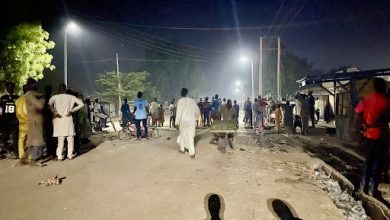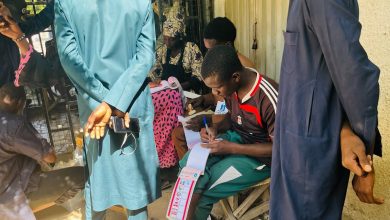Factcheck: No, Buhari Did Not Lift 10.5 Million Nigerians Out Of Poverty In Two Years
The claim by Nigeria's President that his administration lifted over 10 million Nigerians out of poverty is misleading.
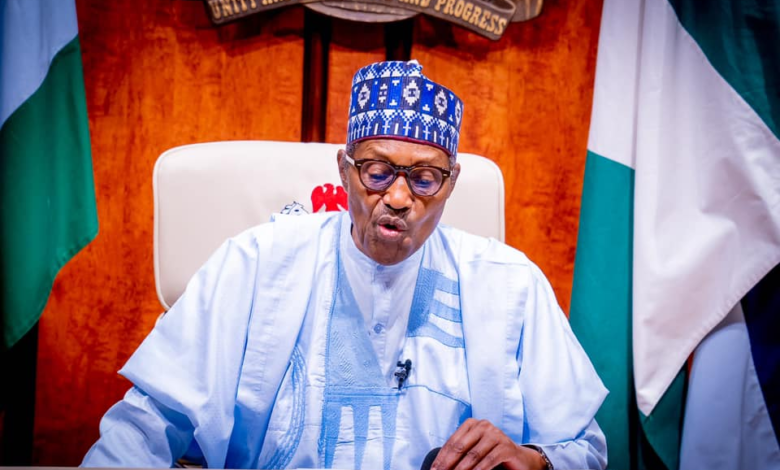
Claim
Nigerian President, Muhammadu Buhari, on Saturday, June 12, 2021, claimed that his administration had lifted 10.5 million Nigerians out of poverty in the last two years.
The president made the claim while highlighting the successes and challenges his administration has faced in his Democracy Day speech.
“In the last two years we lifted 10.5 million people out of poverty – farmers, small-scale traders, artisans, market women and the likes,” Buhari said.
Nigeria’s Poverty Benchmark
According to the United Nations, a person is considered to live in extreme poverty when he or she is living on less than $1.90 per day. This figure is known as the international poverty line.
While there are questions about why the level of poverty in advanced countries should be measured using a similar benchmark, in countries like Nigeria, this benchmark is considered fair and has been adopted by multiple national and international organisations to measure the level of extreme poverty in the country.
How many Nigerians lived In extreme poverty two years ago?
According to the World Poverty Clock, a web tool produced by World Data Lab, 77.9 million Nigerians, representing 39 per cent of the country’s 199 million population, were living in extreme poverty in 2019.
A breakdown of the data indicated that 61 and 11 percent of people who lived in rural and urban areas respectively made up this figure.
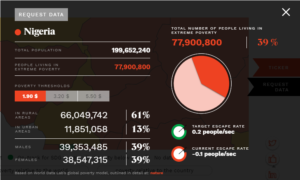
How many Nigerians live In extreme poverty today?
On June 12, 2021, the same day Buhari declared that his administration had lifted 10 million Nigerians out of poverty in the last two years, the number of Nigerians who live on less than $1.90 daily had risen to 86.8 million.
This figure represents 41 per cent of Nigeria’s 209.6 million population, according to the World Poverty Clock, 64 and 14 percent of people in rural and urban areas respectively made up this figure.
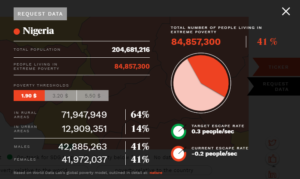
Considered one of the most reliable data sources on the subject, World Poverty Clock provides real-time poverty estimates until 2030 for almost every country in the world, monitoring progress against ending extreme poverty, which is the United Nation’s first sustainable development goal.
According to its methodology, it uses publicly available data on income distribution, production, and consumption, provided by various international organizations, most notably the UN, World Bank, and the International Monetary Fund.
These organisations compile data provided to them by governments in each country. In the few cases when governments fail to provide data, the agency uses models to estimate poverty in affected countries. The agency’s data covers 99.7 percent of the world’s population.
What does the World Bank Say?
In May 2020, Nigeria’s National Bureau of Statistics (NBS) released the “2019 Poverty and Inequality in Nigeria” report.
This report, based on data from the Nigerian Living Standards Survey conducted in 2018-2019 with support from the World Bank’s Poverty Global Practice and technical assistance from the LSMS program, represents the organisation’s view of poverty in Nigeria.
Using a poverty benchmark of 137,430 Naira per person per year, it estimated that 83 million people, which represent 40 per cent of the entire population, were living in extreme poverty as of 2019.
While the World Bank or NBS is yet to release another set of comprehensive statistics on poverty rate in Nigeria, a January 2021 report says macro-micro simulations show that more than 10 million Nigerians could be pushed into poverty by the economic effects of the COVID-19 crisis alone.

The report estimated that without the counter-effect of COVID-19, the poverty headcount in the country would have remained just above 40 per cent “although the number of poor people would be set to rise from 82.9 million in 2019 to 90 million in 2022 due to natural population growth.”
However, due to the economic effects of COVID-19 crisis, the World Bank stated that the poverty rate will continue to rise till it reaches 45.2 per cent in 2022.
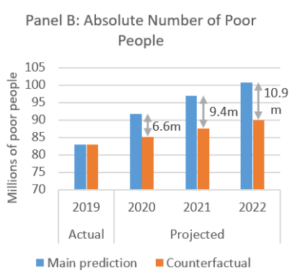
This projection seems fair because it only covers monetary poverty without putting into consideration multidimensional poverty which the World Bank’s Multidimensional Poverty Measure (MPM) currently puts at 47.3 percent.
Conclusion
The claim by President Buhari that his administration has lifted 10 million Nigerians out of poverty in the last two years is FALSE because, rather than decrease, the country’s poverty rate has continued to rise over the last two years.
Support Our Journalism
There are millions of ordinary people affected by conflict in Africa whose stories are missing in the mainstream media. HumAngle is determined to tell those challenging and under-reported stories, hoping that the people impacted by these conflicts will find the safety and security they deserve.
To ensure that we continue to provide public service coverage, we have a small favour to ask you. We want you to be part of our journalistic endeavour by contributing a token to us.
Your donation will further promote a robust, free, and independent media.
Donate HereStay Closer To The Stories That Matter


